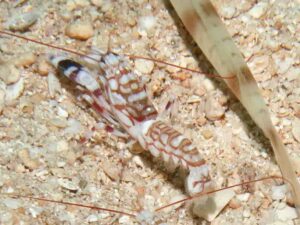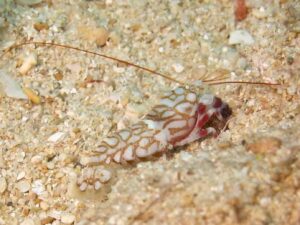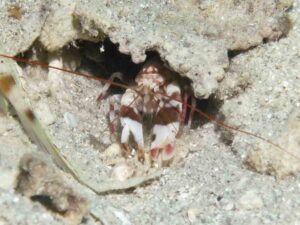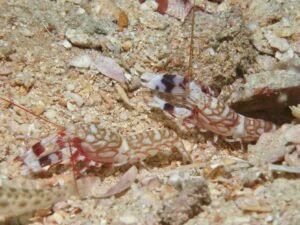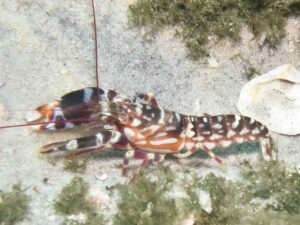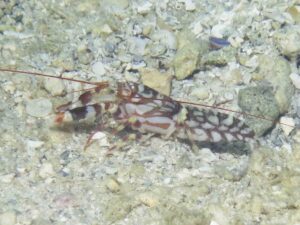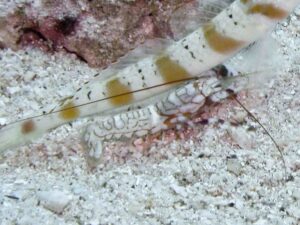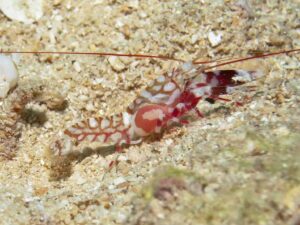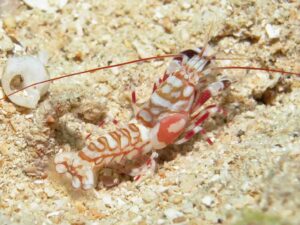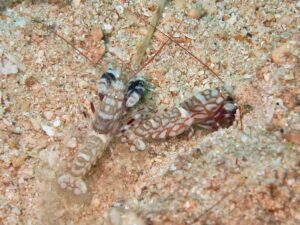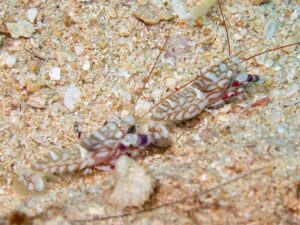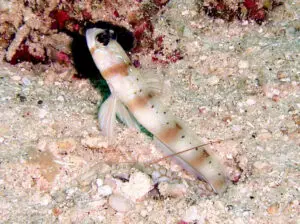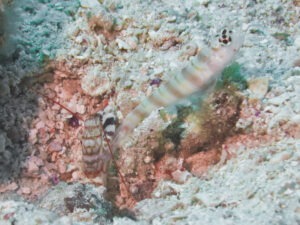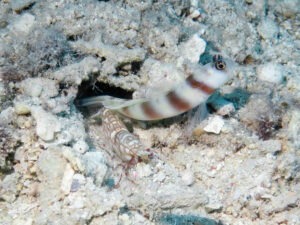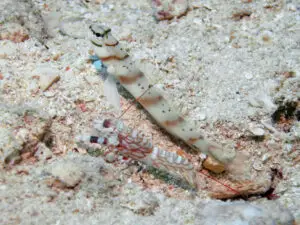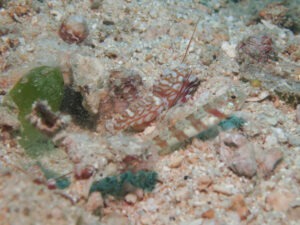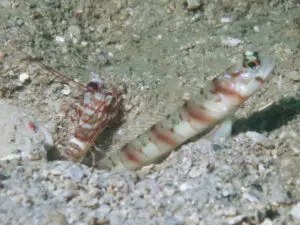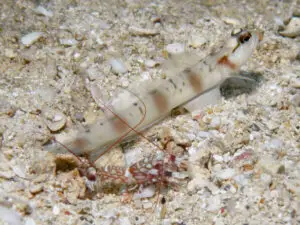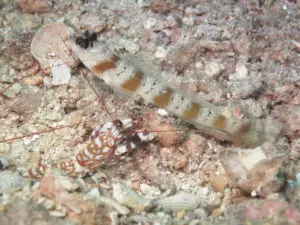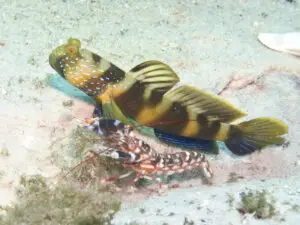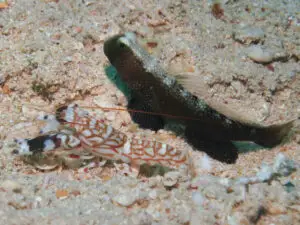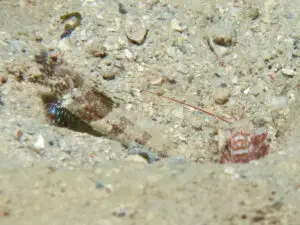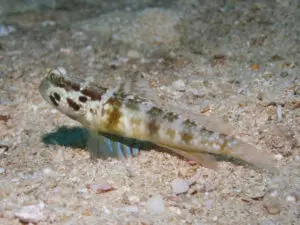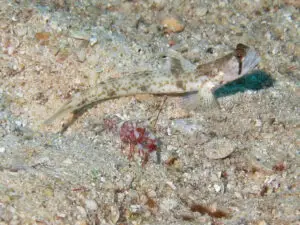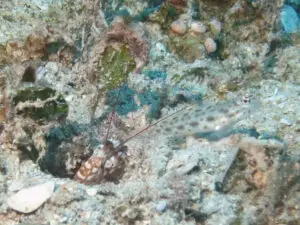Tiger Snapping Shrimp
Alpheus bellulus
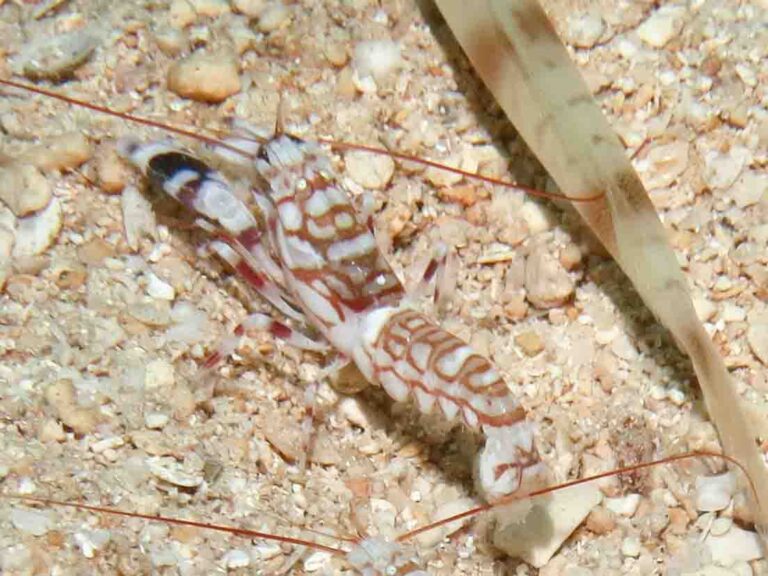
Tiger Snapping Shrimp
Alpheus bellulus complex
Miya and Miyake 1969
Description
A common, boldly patterned and readily identified shrimp, but with striking variants that may or may not be the same species.
Carapace; On white sand the base colour is white with a brown netted pattern separated by a red border. Commonly the network is so thickened and extensive that the pattern appears to be brown with white rectangular patches. This becomes extreme in shrimps living on black sand substrates, but in any habitat each animal differs in the amount of pigment. The one constant is that, like most partner-shrimps, the pattern of two transverse white bands on the dorsum of the carapace is preserved. There is a red outlined white oval on the side of the carapace.
The abdomen retains the white transverse bands on segments 1 and 4. Otherwise the segments each carry the same pattern of a brown network enclosing a white rectangle and a crescent mark on the lateral side. The effect differs according to the individual degree of pigmentation.
The rostrum is white but the antennae and antennules are conspicuously red.
The Pincers are white with conspicuous dark red-black bands varying from narrow to very broad depending on degree of melanism. The two pincers are different with the larger one modified into a powerful weapon. There is often a well defined dark spot distally on the inner aspect of the major claw.
The chelate second legs are red with white joints The walking legs are white with red band either side of the joints.
Identifying Features
Variants, or related shrimps
There is a beautiful dark brown form we have found at Frazer Island, Australia with the dorsal network and nipper bands densely black and the sides contrasting brown and white. The claws are brown with white tips. This variant lives in pale grey sand (usually darkly pigmented individuals occur on black sand) but in this habitat there is an abundance of dark green algae in which it hides.
A common variant found on black sand no longer has a network pattern but is uniformly ochre with very small white rectangular patches.
Lesser degrees of variation are common and are often seen within pairs that share a burrow.
Similar Shrimps
None
Nomenclature
The scientific name Alpheus bellulus, Miya and Miyake 1969 has been applied to this species (Ryanskiy 2015, and virtually all published texts).
Anker 2001 considers the name includes a species complex of three species.
Debelius (2001) Crustacea p152 has images of a similar looking shrimp and gives the name Alpheus bellulus. Length up to 4 cm, egg-bearing (ovigerous) females up to 5 cm. Distribution Indo-West Pacific, Japan (Ryukyu Islands), South China, Thailand, Indonesia, Papua New Guinea probably Seychelles and Australia. There are at least three colour morphs of this snapping shrimp (probably closely related species).
Ryanskiy (2016) p6. has images of a similar looking shrimp and gives the name Alpheus bellulus common name Tiger Snapping Shrimp. Length up to 5 cm. Distribution Indo-West Pacific – Red Sea, Maldives Thailand, Japan, Philippines, Indonesia, Australia.
Humann & DeLoach (2010) p84 has images of a similar looking shrimp and gives the name Alpheus bellulus, common name Tiger Snapping Shrimp. Size to 3. 5 cm. Indo-West Pacific from Indonesia to Papua New Guinea and Australia, also Japan. Shows colour variation.
Hayashi & Shiratori (2003) Alpheus bellulus from Japan.
Roger Steene Colours of the Reef 2015 page 407 has a vividly marked individual on black sand labeled Alpheus bellulus.
Pairs show some variation in colour pattern and pigmentation but not dramatic differences perhaps because the individuals in one habitat are usually all the same pattern. There is an image of such a pair in the slide show opposite.
Ecology
HABITAT
Preferred substrate Equally at home in a pebbly substrate or fine to medium sand with shell debris.
Depth range 5 to 15 metres.
Proximity to reef Burrows are constructed where the sand becomes flat at the base of patch and fringing reefs, usually fairly close to the reef. Burrows often start under the shelter of flat coral rock or, if commenced in sand, incorporate coral or rock further along the burrow.
NATURAL HISTORY
Usually in pairs and readily resume bulldozing after being disturbed.
NATURAL HISTORY
This is one of the more widespread and common species of partner shrimp and would commonly be seen by scuba divers. It forms an association with a number of shrimpgoby species.
The ornate pattern is made up of shapes and colour tones that match the reds, whites and browns of their mixed sand and shell grit habitat and provides camouflage as well as making the aesthetically beautiful design to which the scientific name refers.
Feeds on detritus, algae, Ryanskiy (2016).
Parasites
It is not uncommon to see shrimps with a swelling on one side of the carapace. This is made by a parasitic isopod (Bopyridae) living in the gill cavity under the carapace.
Distribution
Published distribution:
Indo-West Pacific. Japan, Ryukyu Islands, South China, Thailand, Indonesia, Papua New Guinea, Thailand, Probably Seychelles and Australia. Debelius (2001). Indo-West Pacific: Red Sea, Maldives, Thailand, Japan, Philippines, Indonesia, Australia, Ryanskiy (2016). Indo-West Pacific: Indonesia to Papua New Guinea and Australia, also Japan, Humann and DeLoach (2010).
Our records:
Australia, Lizard Island, Tongue Reef, Low Isles, Tryon Island, Frazer Island.
Solomon Islands; Gizo, Kolombangara, Santa Isabel, and Nggela Islands.
Papua New Guinea; Normanby Island, New Britain, Milne Bay.
Vanuatu; Paama Island.
Indonesia; Batanta Island.
Associated Shrimpgoby species
Associated Shrimpgobies (14 species)
Amblyeleotris arcupinna Arcfin Shrimpgoby
Amblyeleotris diagonalis, Diagonal Shrimpgoby
Amblyeleotris gymnocephala, Mask Shrimpgoby
Amblyeleotris ogasawarensis, Redspotted Shrimpgoby
Amblyeleotris periophthalma, Broadbanded Shrimpgoby
Amblyeleotris rubrimarginata, Redmargin Shrimpgoby
Amblyeleotris steinitzi, Steinitz’s Shrimpgoby
Amblyeleotris stenotaeniata, Thinbar Shrimpgoby
Cryptocentrus bulbiceps, Bluelined Shrimpgoby
Cryptocentrus fasciatus, Y-bar Shrimpgoby
Cryptocentrus sericus, Ventral-barred Shrimpgoby
Ctenogobiops pomastictus, Goldspeckled Shrimpgoby
Tomiyamichthys nudus, Scaleless Shrimpgoby
Tomiyamichthys oni, Monster Shrimpgoby

